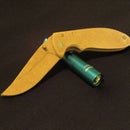Introduction: Chainmaille Rose
I guess this should technically be called a helm rose, because it's made of a section of helm chain joined end to end. In the first few pictures I've used bright aluminum for the silver colored rings and anodized aluminum for the blue rings, to add a bit of color. I got the rings and pliers from The Ring Lord, although you can easily make your own rings at home. There are plenty of 'ibles already out there detailing this process, so I won't bore you with it (and I generally only do it with larger gauge wire anyway).
I got the idea for this after seeing Blue Buddha's Quantum Rose a little while back, and I wanted to create a simpler, cleaner version as well as respect their IP rights to that design. The nice thing about maille is that you can always add or subtract elements to suit your taste, making each and every design your very own. Plus, as this was a Mother's Day present for my mom last year, I wanted to make something special for her :) And true to that, I've only ever made one pendant with those lovely robin's egg blue rings.
As usual, feel free to ask questions!
Materials:
- Twelve 16 gauge 5/16" ID rings
- Four or eight 18 gauge 3/16" ID rings
- Two pairs of pliers (I like to use flat nose in my right hand and chain nose in my left)
- A bail of some sort, I used a spare 18ga. 1/4" ring I had lying around
P.S. If you're wondering why there's an extra "le" in chainmaille, it's the French spelling. Plus, it prevents any confusion between your works of art and those annoying emails you can't delete fast enough. xD
P.P.S. I'm only using four small rings in this 'ible because I don't have the exact components needed to make the double small ring version. Basically, because this process results in such a stiff weave, you need to have just a little bit of extra give to make it work. Unfortunately, I'm out of machine cut rings so I don't have that extra bit of leeway, and therefore making the version you see in the first few pictures is virtually impossible for me right now. However, the process is essentially the same either way.
If you're interested, what I've found works best is aluminum rings from TRL (the ring lord), bright or anodized, all machine cut. The reason for this is that the machines compensate for loss of material by rotating the coil of rings as they're cut. Saw cut rings, on the other hand, are fed through a very thin saw blade, but the thin blade still removes a bit of material, and this results in a marginally smaller ring. Normally this wouldn't matter, but on tight weaves, you better believe it does.













